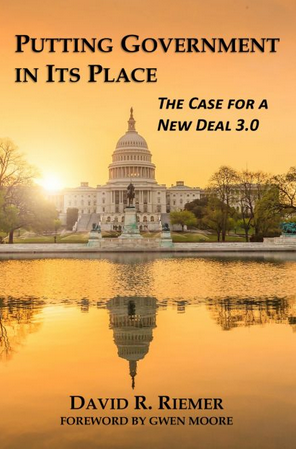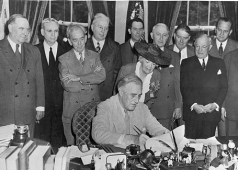The New Deal's Contribution
U.S. domination of the world economy tells only half the story of why America's economy was in such good shape in the post-war era. The other half of the story: the policies adopted during the New Deal and its aftermath.
To begin with, New Deal economic security policies stabilized and raised incomes.
The New Deal's hand in creating economic security and raising incomes was everywhere. Unemployment insurance cushioned laid-off workers when the U.S. economy faced occasional downturns. Federal minimum wage and collective bargaining laws increased workers’ purchasing power. Disability benefits and Social Security pension payments ensured that those left out of the labor market—or who exited it to retire—had a minimum income.
Two other key policies that took hold in the aftermath of the original New Deal also had a profound positive effect on the economy. A few weeks after D-Day and a few months before he died, FDR signed the GI bill that enabled millions of returning veterans to get a college education. Roughly a decade later, President Dwight D. Eisenhower signed the interstate highway bill, whose city-to-city roads helped strengthen the economy.
The G.I. Bill
The G.I. Bill was unalloyed in its positive benefits, at least as far as education is concerned.
Officially titled the "Servicemen's Readjustment Act of 1944, the G.I. bill provided a range of benefits for returning World War II veterans. Benefits included one year of unemployment compensation, low-cost mortgages, and low-interest loans to start a business. Most famously, the GI bill provided veterans with cash payments to cover tuition and living expenses while attending a high school, vocational school, or university. It was available to every WWII vet who had been on active duty during the war years for at least one-hundred twenty days. There was no "poverty-requiring" means test.
By 1956, 5.6 million million had used the G.I. Bill education benefit for some kind of training program, and roughly 2.2 million veterans took advantage of G.I. benefits to attend colleges or universities
Signed by FDR less than a year before his death, the G.I. Bill not only recompensed millions of surviving veterans for their sacrifice to the nation but played a huge role in strengthening the U.S. economy during the post-war era. For the first time in U.S. history, millions of young men and women who never imagined attending college, or who dreamed of it but could not pay the price, found it possible to afford a college education. Read More ->
Responding to the tuition payments and living expenses that former G.I.'s carried with them, the nation’s colleges and universities expanded dramatically. In many states, public universities also received larger grants from state governments.
The investment in higher education quickly began to pay off. As the men and women that former G.I. and later President John F. Kennedy referred to as "a new generation of Americans" became the world's most highly educated workforce, the productivity of the nation's economy soared.
The City-to-City Part of the Interstate Highway Program
The legacy of the Interstate Highway Act is more complex. It helped a lot, and it hurt a lot.
In the 1950s, as more Americans bought and drove cars, they also drove more on local roads and paid more gas taxes to their state and federal governments. Instead of using the growing stream of funds to fix and improve the local roads whose use generated the revenue, state and federal officials diverted a huge part of the money to finance a vast new network network of interstate highways.
This "highway robbery" ultimately did enormous damage to America's environment, vacuumed people and business out of U.S. cities for decades, and worsened racial and economic segregation.
In the short run, however, the interstate highway program achieved the one positive good envisioned by President Eisenhower. As Ike lead Allied forces in the conquest of Nazi Germany, he was inspired by Germany’s autobahn system. The Eisenhower administration worked with Senate Majority Leader Lyndon Johnson to push through Congress a program to build multi-lane, limited-access interstate highways, whose primary purpose was to run from city to city. The city-to-city portion of the highway-building program greatly shortened the time to transport goods between America's metropolitan areas. This in turn helped to increase the overall productivity of the nation’s economy. Read More ->
Tragically, the interstate highway law allowed states to ram giant expressways through America's cities. The program's massive intra-city road-gouging projects inflicted enormous environmental, economic, and social damage on the nation's metropolitan areas. Read More >
Putting the Pieces Together
Now put the pieces of the puzzle together:
- Domination of the world's economy:
- Unchallenged control of the domestic economy;
- A still-new economic security system that provides new types of income to the unemployed, workers, those with disabilities, and retired seniors;
- Still-new market regulation that protects depositors' banks savings and keeps the stock market from going berserk;
- A huge new investment in educating America's returning G.I.s; and
- A massive new investment in building big roads to connect the nation's metropolitan areas.
It is little wonder that the U.S. economy did so well from 1945 through the early 1970s. Unemployment rarely rose above 4%. Incomes rose across the board. The middle class vastly expanded.
Happy days were truly here again...until the daylight began in dim.


